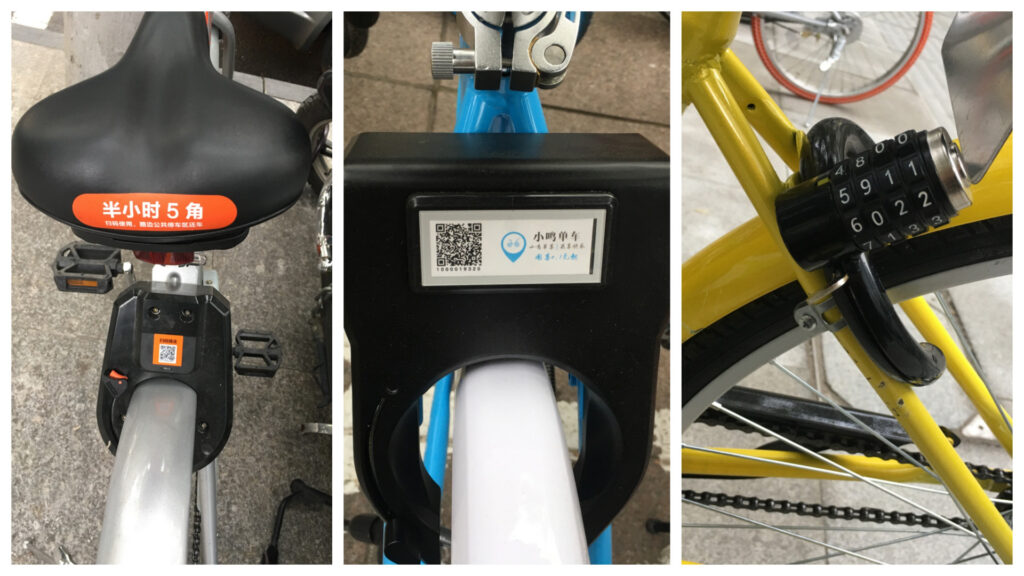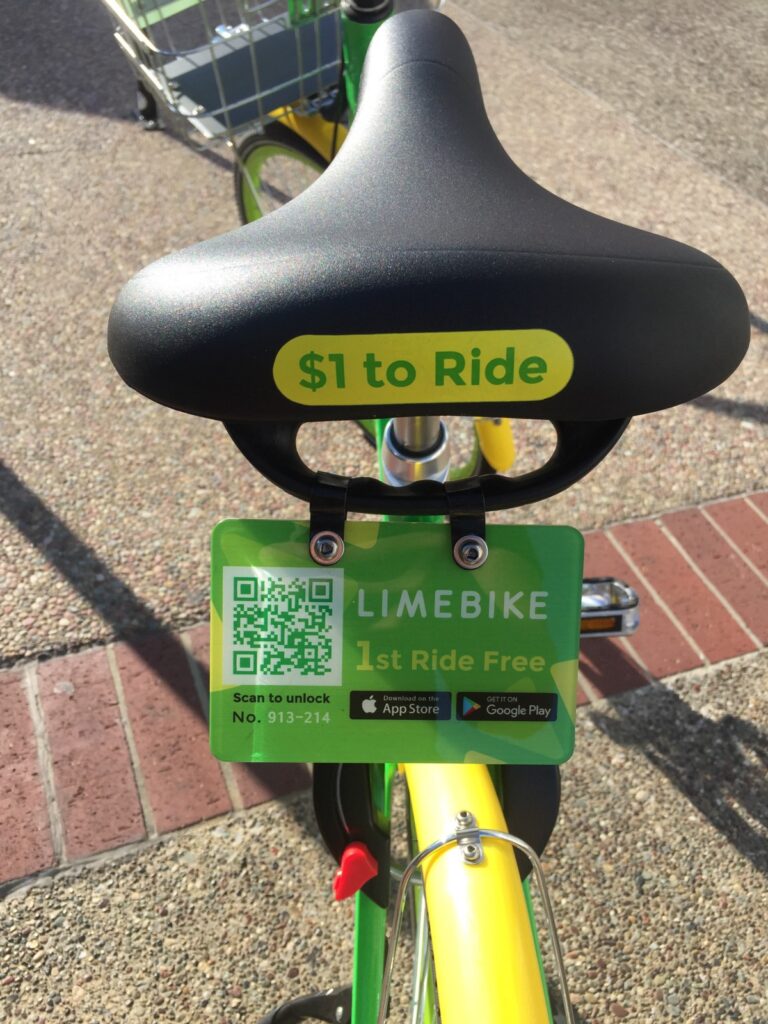
Download the policy brief HERE.
Over the last decade, bikeshare schemes have become a standard feature in cities around the world, with over 1,000 cities offering at least one bikesharing scheme. City governments have incorporated bikeshare into their transportation and sustainability plans as a low-cost and innovative mobility option for residents. More and more cities are realizing the benefits of integrating this reliable, convenient, safe, and affordable mode into their existing portfolio of transport options.
What’s New about Dockless Bikeshare?
In the last couple of years a new approach to bikeshare has emerged: dockless bikeshare. While stationless bikeshare systems, such as Call-a-bike and Nextbike, have existed for years in Europe, they relied heavily on government support, were not reliant on smartphone technology, and never achieved the levels of growth currently underway. The rise of dockless bikeshare, however, comes as a direct response to some of the challenges that traditional station-based bikeshare systems have faced both in terms of convenience for users and the need for public funding. Dockless bikeshare relies heavily, if not exclusively, on smartphone technology and high speed internet, and operators typically charge very low fees on a per ride basis. Supported almost entirely by venture capital funding, dockless bikeshare companies function without government subsidies, allowing them to avoid the often lengthy government procurement processes associated with traditional single-operator, station-based systems.
The current dockless bikeshare system was born in 2014, when five students from Peking University in Beijing founded ofo, a bikeshare company that aimed to serve internal transport needs within the campus. Early in 2016, as the sharing economy, high speed mobile networks, and smartphone technology gained popularity, this new approach to bikeshare began to explode in China.
Compared to traditional bikeshare systems with fixed stations and parking docks, the dockless model allows a rider to leave a bike wherever they decide to complete their trip. There are no fixed stations or parking docks; bicycles are equipped with a self-lock. Riders download a company’s app which directs them to the nearest bicycle that can be unlocked, in most cases, by scanning a QR code with their phone. Some companies, however, also offer the option to unlock a bike by having a pin sent to the user’s smartphone via text, which is then entered onto a keypad or combination lock on the bike.
Image Credits: (1, 3) Emma Lee, (2) Richard Darsono , (4) David Alpert
An Explosion of Bikes and Biking
As of October 2017, there were more than 70 dockless bikeshare companies in China operating approximately 16 million bikes. More than one third of these bikes, about 5.1 million, are located in just three cities: Beijing (2.4 million), Shanghai (1.5 million), and Chengdu (1.2 million) – all of which have traditional station-based bikeshare systems in place. Often, these quantities of bikes were dropped on city streets within a matter of months. The two private operators with the largest market share, ofo and Mobike, together operate approximately 14 million bikes in more than 165 Chinese cities with users taking more than 60 million trips per day, on average.
The intense influx of bikes has made a difference in mode share. In both Beijing and Shanghai, the number of car trips under five kilometers has fallen for the first time, according to The Report of Traffic Analysis in Major Cities (Quarter 1, 2017, AMAP, an online map provider). The decline corresponds with the introduction of dockless bikeshare. A white paper published by Mobike earlier this year shows total bike ridership – not just shared bikes – has increased significantly among Mobike users. An analysis done by ITDP China also found a shift away from walking since dockless bikeshare launched.
Oversupply and Lack of Regulation Creates a Public Nuisance
While dockless bikeshare has given consumers a flexible, inexpensive transportation alternative to driving a personal vehicle, it has also yielded negative consequences such as blocked sidewalks and vandalism of the bikes. Oversupply has led to graveyards of bikes, and deep concerns about quality control, maintenance, and management of these systems. According to a common position paper from UITP, the European Cyclists’ Federation (ECF) and its Platform for European Bike Sharing and Systems (PEBSS), there is a lack of redistribution efforts by private operators – with bicycles sometimes inundating popular areas in the cities – compounded by a lack of maintenance and comparatively low number of staff to manage the bikes. The initial lack of regulations and massive influxes of venture capital funds allowed these problem to quickly grow.
Image Credits: (1) Jason Lee (2)Mark Schiefelbein (3) Gregor Fischer
Lack of Financial Transparency Raises Concerns
It is not clear how financially viable dockless bikeshare companies will be in the long term. This boom created in China is, in part, due to massive funding from private investors, which has allowed these young companies to not only flood Chinese cities with bikes, but to explore market potential in Europe, Australia, and North America. Earlier in 2017, ofo raised $700 million while Mobike raised $600 million in venture capital funding. Combined, ofo and Mobike have raised $2.2 billion of capital and are valued at more than $4.4 billion.
While dockless bikeshare operators generate revenue from a combination of user deposits, usage fees (which are very low, at about $1 per ride in the US), in-app advertising, and possibly from user data, it is unclear how stable or sustainable this business model is without continued venture capital investment. To that end, after almost two years in operation, ofo and Mobike remain unprofitable. Several of the smaller dockless bikeshare companies have started merging to try to corner more of the market, and even more troubling, Bluegogo, the third largest bikesharing company in China, went bankrupt at the end of November causing 20 million users to lose their deposits.
Despite receiving such large amounts of funding, major operators like ofo and Mobike have not scaled up at nearly the same pace outside of China as they did within the country. This is likely due, in part, to cities raising serious concerns about the bike graveyards, vandalism, and opaque business practices seen in China. While initially, cities in the US and Europe were quick to issue cease and desist orders to companies that dropped bikes without warning, many cities have now begun to enter into dialogues with operators, allowing dockless bikeshare to come into the city under certain terms.
Cities Explore Dockless Bikeshare Regulations
According to ITDP China, self-regulation by the market will not fix the problems that have emerged as a result of dockless bikeshare oversupply in China. Governments need to take a more active role in regulating these new systems because, while privately owned and operated, they rely on public infrastructure where there is already conflict over limited space. It is also up to governments to ensure equitable distribution and access to bikeshare as a low-cost transportation mode. In the past six months, the national government and more than 10 cities in China have started implementing policies to guide and regulate dockless bikeshare systems, focusing heavily on bike parking guidelines. Some cities, like Shanghai and Beijing, have even banned any additional shared bikes from current or new operators from entering the market.
As dockless bikeshare expands outside of China, cities are bracing for the impact. In the US, Seattle and San Francisco established permit requirements for private bikeshare operators that include safety, parking, operations, and data sharing as part of a pilot project before allowing the systems to go into full operation. Other cities, such as Washington, DC and Dallas, are taking more of a “wait and see” approach, allowing multiple dockless bikeshare companies to operate during a pilot period with limited regulation, and with the intention of crafting rules based on behaviors observed during the pilot. In Europe, best practices have already begun to emerge from cities like Manchester (UK), where the transportation agency is working closely with Mobike towards city wide cycling and mobility as a service (MAAS) goals. Interestingly, operators themselves are beginning to call on city and national governments to clarify rules governing dockless bikeshare operations so that they can follow a standardized framework across their markets.
ITDP’s Role
As an organization devoted to sustainable transportation, ITDP believes that shared mobility is critical for not only sustainable transport, but also to achieving transit-oriented instead of vehicle-oriented development and reducing overall car usage and ownership. To that end, we encourage proactive, outcome-oriented policies that are flexible to context, opportunity, and technology changes. For many people, bikeshare can serve as a first introduction to the concept of shared mobility, and despite the current lack of funding needed by dockless bikeshare companies to operate, cities still need to be actively involved in how bikeshare is planned, implemented, and operated within their boundaries.
With this in mind, we’re pleased to kick off this series of blog posts exploring case studies and emerging best practices for how to integrate dockless bikeshare into a city’s sustainable transportation portfolio. Our next post looks at how one city in China, Tianjin, has approached dockless bikeshare regulation. The third post in the series will explore how Guangzhou, China is balancing its traditional station-based bikeshare system with an influx of dockless bikes. Finally, we’ll close out the series with a post presenting policy frameworks for cities open to dockless bikeshare.





